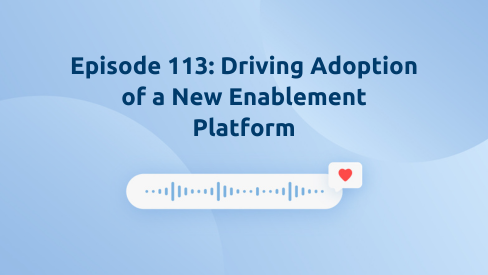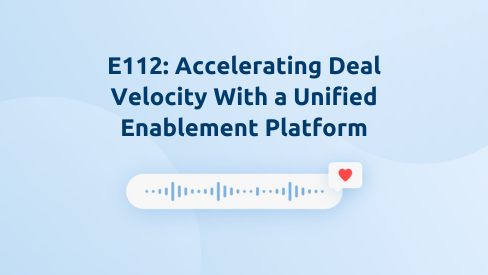According to research from Forrester, organizations that align their go-to-market teams grow 19% faster and are 15% more profitable. So how can you foster effective cross-functional communication to break down silos and secure leadership buy-in for your enablement strategies?
Shawnna Sumaoang: Hi, and welcome to the Win Win podcast. I’m your host, Shawnna Sumaoang. Join us as we dive into changing trends in the workplace and how to navigate them successfully.
Here to discuss this topic is Sonal Patel, the director of GTM enablement at Rakuten. Thank you for joining us, Sonal. I’d love for you to tell us about yourself, your background and your role.
Sonal Patel: Thank you for having me. So my name is Sonal Patel. I’m born in the fantastic city that is London, UK. Shout out to any fellow Londoners listening in. That was my base until about two years ago where I got an opportunity to relocate to US. I’m now living in a much warmer climate based out of Frisco, Dallas. So a little bit about my background. I started my career in digital marketing affiliates client side, which led me to join Rakuten Advertising, managing clients and leading the UK client services team. From there, I moved into a strategy and sales engineering role, supporting sales teams this time with deal analysis, pricing profitability, which was a great transition into sales enablement where I now support commercial teams globally.
SS: We’re so excited to have you here now at Rakuten. You have held roles across the go-to-market organization from account management to client services and operations. Talk to us about your journey into your current role and how this experience influences your approach to go to market enablement.
SP: Yeah, sure. How much time do we have for this one? Okay. So as I said, I started my career in client services and account management, and this gave me a deep understanding of client, needs and the challenges of building strong relationships and really driving that customer satisfaction. Managing complex accounts, leading high performing teams taught me what it takes to really deliver results.
This experience, I would say shaped my approach to enablement. I focus on supporting commercial teams today with the right tools, a clear messaging, and content that really aligns with client expectations and business goals. I also, in this role, work very closely with our delivery teams to help our commercial groups really navigate that internal noise, ensuring that we’ve got alignment. So this spans across teams like product, product marketing, marketing, sales solutions, and more.
SS: I love that journey. On LinkedIn, you also mentioned that you specialize in helping leaders overcome challenges to drive success. Can you share an example of a challenge that you’ve been able to help overcome for your business through enablement?
SP: Yeah, a big challenge I came to understand is for our sellers really tailoring the experience to buyer needs while navigating really lengthy sales processes to stand out in the market. We really needed to streamline our messaging and make that experience more impactful. So one way I tackled this was by implementing digital showrooms, taking you back a bit.
It started when a seller ran out of time during a pitch process to demo our dashboards. So we created short bite-sized demo videos showcasing our features. That prospects really cared about the most. And from there, I developed custom digital room templates that basically allows our sales teams to share our full product suite, as well as RFP documents and all of those documents that is needed within that sales process in less than five clicks.
So this has been an absolute game changer. It’s helping us deliver tailored, engaging experiences, while really most importantly, simplifying that process for our sales teams.
SS: Another common challenge I hear a lot about, I know a lot of enablement teams face, is gaining leadership buy-in, and this is an area where you have had a lot of success.
I’d love to understand, what are some of your best practices for securing support for your programs from your executive leaders?
SP: Yeah, sure. Great question. Securing leadership buy-in is tough. It’s not just about getting your foot in the door, it’s about keeping it there. It’s taken me years to figure out, if I’m honest.
For me, it comes down to three things. Identifying the right stakeholders. Understanding their pain points and keeping the relationship ongoing and fluid. One aspect I’ll talk about here is early in my career, I thought I was a good listener, but I was really just waiting for my turn to talk. I’d latch onto a keyword and start crafting my response instead of actually processing what was being said.
But when I started truly listening, things started changing. Leadership tells you exactly what they care about. And problem solving becomes a two-way conversation by focusing on their needs. And showcasing how my programs address their priorities. I’ve been able to build that trust and secure their support.
But like I said, it’s taken years to really figure that out. It’s not a one-time effort. It’s really about maintaining that dialogue, staying adaptable and really continuing to deliver that value over time. So a lot of perseverance, I’d say it doesn’t come overnight. But yeah, I would go back to those kind of three things that I really identified to really help secure a leadership buy-in.
SS: And what would you say is the impact of having strong executive support for enablement?
SP: Strong executive support, I’d say is critical for enablement because it really drives that credibility, the prioritization and the adoption across the organization. It also ensures enablement is seen as that strategic function that it really is that impacts business outcomes and it’s not just a nice to have.
I’m a pretty lean team here at Rakuten Advertising. So that again has taken. A good few years to really establish when leaders champion enablement, it really helps break down those silos. It aligns teams towards shared goals, secures the resources. I really need within enablement to really scale programs.
And most importantly, I’d say, it fosters a culture of continuous learning, really empowering those teams to perform at their best and deliver better results for the business, ultimately, is our shared outcome.
SS: Now, beyond executive leaders, how do you build and maintain strong relationships with key stakeholders at all levels of the organization, like cross-functional partners and frontline reps?
SP: Yeah, great question. Another one that could probably spend a long time talking about. Building strong relationships with key stakeholders, especially reps. It’s all about the three pillars, if you like, which is consistency, collaboration, and trust. I focus on building rep relationships first, since they’re the ones using the tools and programs we create.
One way I’ve done this is by launching a champions program. So partnering with our early adopters to test use cases, gather their feedback and then refine programs. So these champions also provide testimonials that have really helped me drive adoption across the various projects and deliverables that I’ve set out.
It does take time and perseverance to build that trust and credibility, but it’s incredibly worth it. I also lean on my support system. What I mean by support system, this is my mentors at work, external enablement resources and events, coffee chats with other enablement professionals to really stay sharp and learn from their experiences.
And I bring that into the activity that I’m running as well. So I’d say staying connected and open to feedback has really helped me build those kind of strong and lasting relationships.
SS: And how have these strong stakeholder relationships helped you optimize and innovate your enablement programs?
SP: Great question. The stakeholder relationships are really key for any enablement leader, in my opinion, because enablement is a partnership with sales leaders. We’re not the stick when enforcing things. We need sales leaders to really drive that accountability and frontline managers as well have to get behind the programs that we create for them to really succeed.
My role, or an enablement role if you like, is to execute, really protect our sellers. And keep that chaos down by streamlining their experience. So when you have that trust and buy-in from stakeholders, from frontline managers, it’s easier to get that honest feedback to make improvements and create programs that actually work and are embraced by the team. So you’ve got that buy-in across all levels.
SS: I love that. Shifting a little bit, one area where you’ve started to see a lot of traction with your reps is in the use of Digital Rooms. Can you tell us about your strategy for leveraging Digital Rooms and some of the results you’re seeing so far?
SP: Yeah, so Digital Rooms have been a game changer for our reps.
I spoke about this a little bit earlier. I’m going to go into a bit more detail. It all started when we couldn’t do a live demo during an RFP pitch. So working closely with sales reps and sales solutions, I created our first digital showroom tailored to our client’s needs, including 25 plus custom videos, centralizing resources, such as RFP decks, commercial proposals, and case studies.
From there, I worked with sales leaders to get their buy-in. And what I mean by that is I took this one room that we created. Showcased it to sales leaders, and that led to the creating of regional and then vertical-specific rooms. After a lot of, I’d say, initial hand-holding and training, reps can now create a bespoke room in just under five clicks.
We’ve scaled to over ten global templates, and these rooms are really helping reps deliver more tailored, impactful experiences, while making the process so much easier for them. A recent win for the business. That we secured in our sales or prospect actually called out the digital showroom as a standout feature versus competitors.
They were speaking to it’s building that kind of trust, building those testimonials, going back to having your champions on the field. That’s really helped us kind of elevate digital showrooms and get the adoption that we have today.
SS: Fantastic results. And on that note, how do you measure the impact of your enablement strategy and demonstrate that impact to your stakeholders? Are there any key wins you can share with us?
SP: One way I measure the impact of enablement strategy at Rakuten is using heat maps to track activity on playbooks and initiatives. So we have a number of different plays that we push out to the business using high spot as well as digital room and pitch activity.
So I share this with leaders to really show that engagement. I also work very closely in conjunction with sales leaders, as well as. Working closely with our content SMEs. So all of our subject matter experts that are producing a lot of this content to review the success of it. So the metrics that I focus on here are internal usage, as well as external engagement, especially through digital rooms by setting shared goals with all of these stakeholders quarterly.
It helps my efforts stay aligned and focused on delivering business outcomes that we’ve set out. So it is a shared best practice there.
SS: Last question. For enablement leaders looking to gain leadership buy- in within their organization, what is the biggest takeaway you’d leave them with?
SP: I’ll share three takeaways with you that have really resonated with me. First is listen first, then act. And what I mean by that is take your time to truly understand leadership pain points and priorities. This took me years. Build trust by showing you’re solving their specific challenges and you’re not just pushing your own agenda.
Second, I would say align enablement to business goals. Really clearly connect your programs to measurable outcomes that matter to leadership. So things like revenue growth, pipeline acceleration, or improved rep performance. Show them the why behind your initiatives.
And then finally, the last thought I’d leave you with is around building those ongoing relationships. It’s really key. Leadership buy-in isn’t a one- time effort. Keep that relationship fluid by regularly sharing progress, results, and feedback, and really make them feel like partners in the process, not just stakeholders.
SS: Thank you so much, Sonal, for joining us. I really appreciate it.
SP: Thank you. Closing remarks, if I may, I would like to give a quick shout-out to some of my enablement coffee chat mentors that I talked about. The impact that a lot of the individuals I’m about to share with you have been really pivotal to my enablement journey and where I am today, my coffee trap mentors include Sheevaun Thatcher, Del Nakhi, Kate Jack, they’re all pretty big influences in the enablement space and they were fantastic to take some time out to speak to me about. They started their career in enablement and I was able to take a lot of those learnings and apply them to my day-to-day.
Highspot leaders. We’ve got some fantastic mentors that I leaned in a lot and I continue to lean in. Raksha, Lisa, Laura in EMEA, and Matthew. And then finally my manager, mentor friend who gives me the space to really grow, test and learn and has been and is instrumental in contributing to my enablement success in recent years. And that’s Eric Nakano.
SS: To our audience. Thank you for listening to this episode of the Win Win podcast. Be sure to tune in next time for more insights on how you can maximize enablement success with Highspot.



